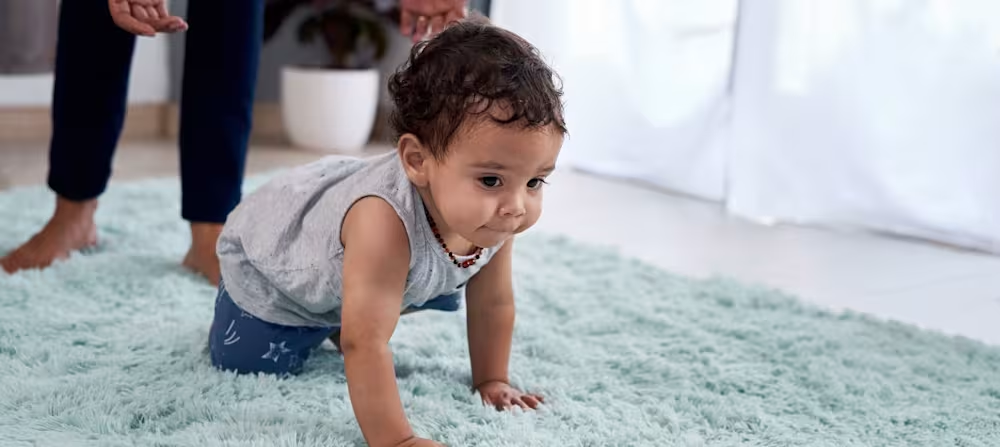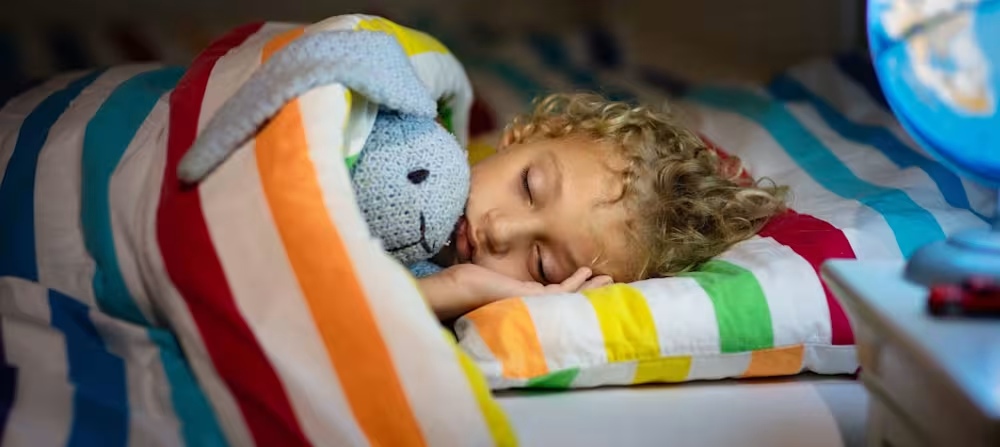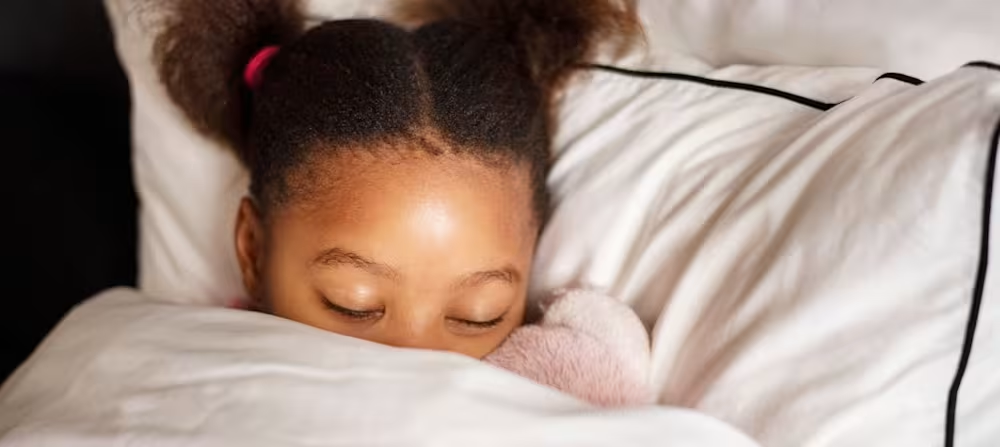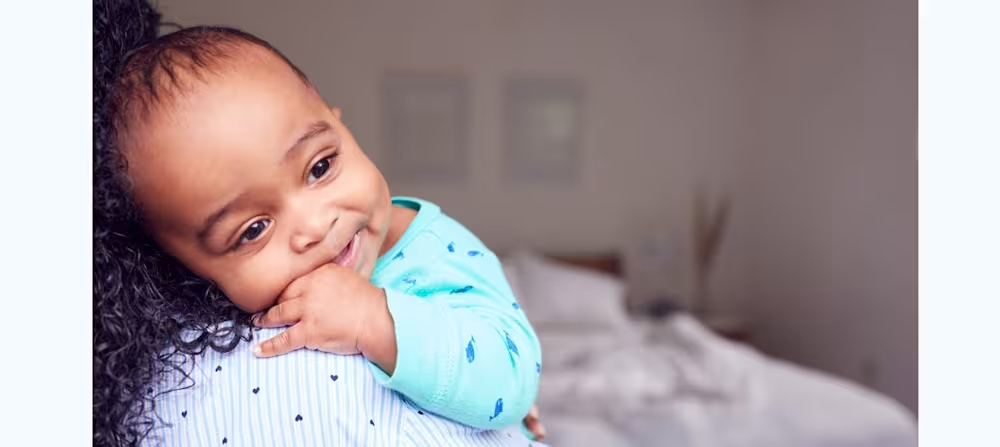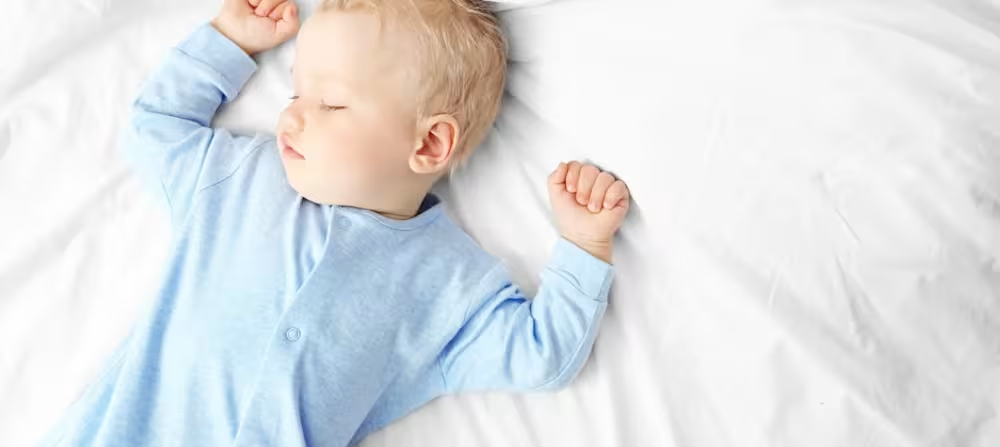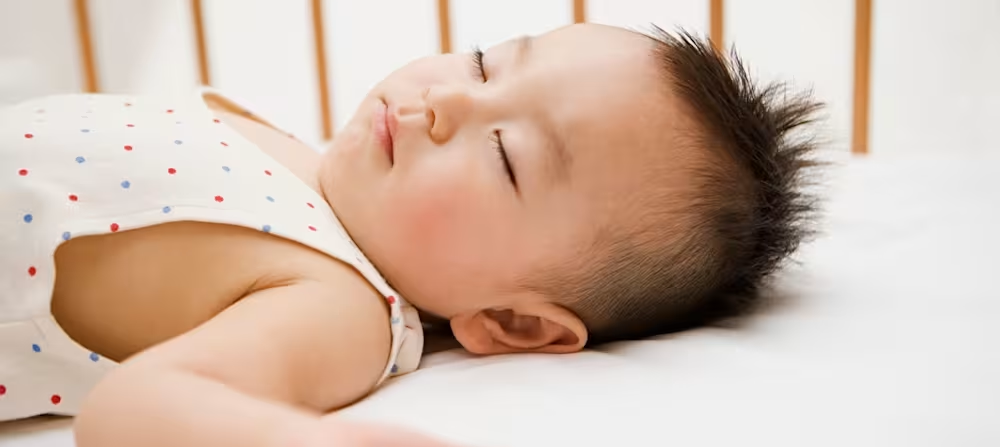Can newborns sleep on their side? How safe is it?
Updated Dec 29, 2025

Newborns sleep a lot. Many newborns average around in a 24-hour period, making safe sleep habits especially important during their first few months of life. As your little one adjusts to sleeping outside of the womb, they may wiggle into various positions for comfort, such as their side, leading many parents to wonder: Can newborns sleep on their side safely?
Here, we’ll look at when it’s safe for infants to sleep on their side, the risks of doing so too early, and what to do if your little one rolls to their side while sleeping.
Table of Contents
Is it OK for babies to sleep on their sides?
While it’s normal for babies to roll onto their sides during sleep, the safest position for younger babies is flat on their backs. That’s why the American Academy of Pediatrics (AAP) recommends always placing babies under 12 months onto their backs for sleep. Side sleeping may cause babies to roll onto their stomachs, which puts them at a higher risk of Sudden Infant Death Syndrome (SIDS) [].
Risks of side sleeping
Infant sleep safety is a delicate topic, and years of research have been dedicated to learning how to keep babies safe! As a result, we now know that SIDS can occur if babies are unable to wake themselves up if they’re not getting enough oxygen []. Side sleeping may increase this risk if a baby is unable to roll back (or rolls onto their tummy) and their oxygen intake is affected.
Along these lines, the potential for choking can occur if a baby spits up while on their side or stomach. Here’s why: The tube that leads to a baby’s stomach sits above the tube leading to their lungs. Due to gravity, this causes any fluids coming up from the stomach to gather at the entrance of the lung tube, which can increase the likelihood of choking.
Thankfully, by following AAP safe sleep guidelines [], including always placing your baby to sleep on their back and keeping their sleep space free of suffocation hazards like pillows and blankets, you can significantly reduce the risk of SIDS.
What to do if your baby rolls onto their side during sleep
If it seems like your newborn likes to sleep on their side, you may be dealing with the “newborn scrunch.” This is when a baby curls onto their side after being placed on their back — an involuntary reflex during the first two months that is not a sign of rolling. (It’s just a comfortable position they learned in the womb!) Since the safest position for babies under 12 months old is on their backs, you can gently reposition them if you see it happen.
If your little one is able to roll both ways (tummy to back and back to tummy), it’s generally okay to leave them on their side if they roll that way while sleeping []. Only if you’re comfortable, of course!
? If your newborn shows signs of rolling (beyond the "newborn scrunch"), stop swaddling immediately for safety reasons.
Tips for preventing side sleeping in the first 12 months
Tip | Why it helps | How to do it |
|---|---|---|
Build strength with tummy time | Strong neck, core, and arm muscles help babies roll both ways, which makes sleep movement safer over time. | Start tummy time early and work toward 15 - 30 minutes a day by around 7 weeks, broken into short sessions. |
Place your baby on their back for sleep | Back sleeping significantly lowers the risk of SIDS and other sleep-related dangers. | Put your baby down on their back for every sleep, even if they later move on their own. |
Keep the sleep space clear | Loose items increase suffocation risk if a baby rolls to their side. | Use a firm mattress with a fitted sheet only — no pillows, blankets, toys, or bumpers. |
Avoid positioners and inclined sleepers | These products can restrict breathing or increase the risk of suffocation. | Skip docks, pods, wedges, and inclined devices, even if marketed as “sleep aids.” |
Align all caregivers on safe sleep | Consistent practices reduce risk and prevent confusion, especially with older advice. | Talk through the current AAP guidelines with anyone who puts your baby to sleep. |
It’s natural for babies to toss and turn while sleeping. While you can’t prevent them from moving around, there are steps you can take to help keep them as safe as possible!
Tummy time is an important tool in building your baby’s core, neck, and arm strength. This helps them develop the ability to roll from tummy to back and back to tummy. Once rolling both ways is established, side sleeping becomes much safer — and, if you wish, you can stop moving them to their back whenever it happens. You can introduce tummy time from birth. Once your little one reaches 7 weeks old, try aiming for 15 to 30 minutes of tummy time each day [].
It’s also important to have a conversation with any caregiver responsible for putting your baby to sleep — especially those from previous generations who were taught to put babies to sleep on their stomachs before the Back to Sleep campaign in the early 1990s. While well-intentioned, they might not be aware of current sleep guidelines and the risks associated with older practices []. It’s helpful to emphasize the importance of placing your baby on their back to sleep and keeping their sleep space free of pillows, toys, stuffed animals, comforters, loose blankets, bumper pads, or anything else that may increase the risk of suffocation if they roll over.
Along these lines, the AAP strongly advises against the use of sleep positioners and inclined sleepers (sometimes called docks, pods, loungers, rockers, or nappers). Sleep positioners increase the risk of suffocation if a baby presses their face into the soft padding, while inclined sleepers may cause them to fall asleep in the chin-to-chest position, which can restrict their airway [].
In addition to these tips, consider AAP-recommended safe sleep guidelines, including:
Always put your baby to sleep on their back on a firm, flat sleep surface (i.e., a crib or bassinet). Back sleeping reduces the risk of SIDS, suffocation, choking, and overheating.
Watch for signs of overheating, such as sweating, a hot chest, or flushed skin.
Share a room (not a bed) with your baby for at least the first six months.
Offer a pacifier at nap and bedtime, as it is associated with a decreased risk of SIDS [].
When is it safe for babies to sleep on their sides?
Between 4 and 7 months, babies usually develop the ability to roll both ways (back to tummy and tummy to back). Once they’ve comfortably mastered this skill, the AAP advises that it’s okay to leave them on their side or stomach if they roll over during sleep [].
Are there any advantages to side sleeping?
While side sleeping does not offer any health benefits for little ones, some babies find it more comfortable — and that’s okay! As long as they are able to roll both ways, you can let them enjoy snoozing on their side .
If you believe your baby may benefit from different sleep positions because of certain medical conditions, it’s best to seek advice from your medical provider.
Takeaway
For the first 12 months, back sleeping is the safest position for babies.
Once a baby is able to roll both ways (tummy to back and back to tummy), it’s okay to leave them on their side if they roll that way in their sleep. If they can only roll one way, you should gently return them to their back if they roll onto their side.
Consider following AAP-recommended safe sleep guidelines to reduce the risk of SIDS: Put your baby on their back on a firm, flat sleep surface (such as a ) that is free of blankets, stuffed animals, bumper pads, pillows, or anything else that may increase the risk of suffocation. Watch for signs of overheating, including sweating or a hot chest, and share a room (not a bed) for at least the first six months.
To help your baby keep your baby safe when they roll to the side, you can keep their sleep space free of blankets, pillows, stuffed animals, bumper pads, or any product that can increase the risk of suffocation.
Always reach out to your child’s doctor if you have any concerns about your child’s growth and development.
Baby side sleeping FAQ
Share article:
Note: The content on this site is for informational purposes only and should not replace medical advice from your doctor, pediatrician, or medical professional. If you have questions or concerns, you should contact a medical professional.
9 Sources
Table of Contents
Share article:



